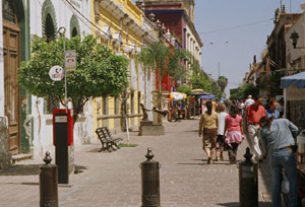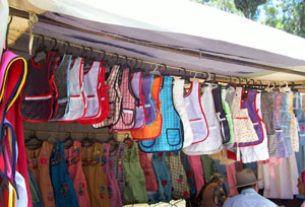The privatization of the facilities of the port of Veracruz in 1996 and open competition for market share between the country’s main operators, have led to significant improvements in the port’s overall handling capacity and services, says sources, while major expansion projects are underway to further improve the overall structure of the major deep sea port.
Shipping agencies, exporters and importers operating in Veracruz port on the Gulf Coast all agree that efficiency is much higher today. Moves to privatize the Veracruz port began in 1996 and saw a handful of private operators move in and take over administration and management from the government-run company Almacenadoras Sur (Alsur).
New business opportunities led construction giant Empresas ICA to form a joint-venture called ICAVE along with Filipino operator Ictsi to run the main container terminal and one of the port’s original grains terminals. Private operator TCE took over management of the Veracruz port’s second grain terminals.
“The place is really run quite efficiently now,” says Ferdinand Kurt, director general of Swiss freight forwarders Kuehne & Nagel’s Mexico office. “The port has every now and then some congestion problems because of lack of infrastructure, but on the whole there is no question that it’s gotten better and I cannot say we are having any major problems with the port,” Kurt says.
ICAVE is putting final touches to a series of multi-million dollar modernization projects which will see general cargo handling facilities greatly improved by its completion next year, shipping sources and company officials say.
“ICA is constantly seeking to upgrade and improve the productivity, the services and facilities of the terminal and the overall operation, and several expansion programs are taking place now and in the next few years,” a spokesman for ICA says.
Once completed, the modernization program will almost double terminal handling capacity at ICAVE’s facilities, from 360,000 TEUs (twenty foot container units) to 520,000, while its overall terminal area will be expanded to cover 345,000 square meters from the former 277,000 square meters, according to project documents.
Stacking capacity will be increased to 540,000 TEUs from the existing 400,000. ICAVE is also in the process of building a second berth, which wil l bring the total length for company’s two berths to 507 meters, compared to the 360-meter-long original berth, left behind by the government. “Other improvements to be undertaken include the construction of a second Container Freight Station while the installation of an additional 180 reefer points was completed last year,” reads the project document from ICAVE.
The project also contemplates the setting up of special warehousing facilities in a “railroad transfer zone,” while an additional 53,000 square me ters in the port area under ICAVE administration and management in the port of Veracruz were paved during 1998. New cooling facilities had also been installed in areas for special freight.
Veracruz port, which was the first built in the Americas after Cortez set foot on the continent in the 16th century, is Mexico’s largest and most important port, and serves today all of Mexico’s central and southern states with the extensive rail and road networks directly connected to the port. The port serves with its direct access to the Atlantic Basin all the eastern coast of North America, Central and South America, Europe and Africa.
Veracruz has today nine specialized terminals, which include containerized cargo, naval vessels, agricultural bulk, fluids and mineral bulk, sugar, ship repair and construction, general cargo, automobiles, petroleum and derivatives, according to official port data.
“With all the work done by the ICA-run terminal the overall operation has already become much better, even if they are still in the process of re-organizing,” says Robert Day of major U.S. commodities trader Cargill’s local office in Mexico, which actively uses Veracruz port for both import and export operations.
Day says that both ICAVE and TCE now operate berths with a mini mum depth of 35 feet, compared to the former government berth which only had a depth of 31 feet and which used to cause delays and expand waiting time for ships loading or unloading cargo in Veracruz.
At the TCE terminal (which deals with specialized cargo), storage and handling facilities for grains have since the beginning of the year been operating at double capacity compared to that of last year.
TCE’s handling and storage capacity rose from 36,000 tons to 72,000 tons with the building of six new silos in addit ion to the original warehouse, as Mexico’s grains import demand continues to rise, according to TCE investor relations manager Arturo Sanmiguel. “We now have all the new storage and handling facility expansions fully installed and operating. Before we only had the warehouse, which we took over from the government in 1996, with a capacity of 35,000 tons. Now we have six new silos with a capacity of 6,000 tons each in addition to the warehouse,” he says.
“All the piers were only 31 feet deep, but since August 1998 the TCE berths have now been increased to 36 feet, which is good because we can handle much larger vessels,” says Sanmiguel.
Veracruz port grains imports were estimated at some 4.6 million tons in 1998\emdash mostly corn, wheat and sorghum from the United States\emdash compared to 3.3 million tons in 1997. Today Mexico’s 45 percent of total grains imports come through Veracruz.
This Gulf port as a whole handled a total of 9.65 million tons of imports in 1998, and 2.85 million tons of exports, according to port statistics. With the new facilities, TCE has significantly increased its market share and is now handling the majority of the agricultural cargo imports to the port. For the first five months of 1999, TCE handled (51 percent of total grains) 1,116 million tons from 39 vessels.
This was 51 percent of the total grains received in Veracruz during that period which reached 2,210 million tons, and 52 percent more tha n in that same period of 1998, where TCE figures show the company during the Jan-May period handled only 736,165 tons of imports from a total of 29 vessels.
Furthermore, the TCE terminal has for the last year been running a new computer operative system for the unloading of grains imports in addition to a new online customs service through which clients electronically can track their shipment deliveries.
“The system has now been in operation for more than one year. Thanks to it, customers are allowed a 24-hour online access via the Internet to a special section of our website, through which they can check when their cargo wi ll arrive and at which berth, and then be able to organize the exact number of railcars needed for further shipment,” he says. Meanwhile, ICAVE has also completed construction of new customs clearing area in order to speed up the clearing process, and has similarly to TCE built a new deeper berth so that vessels can get in to discharge quicker.
“Some years ago we had problems where vessels were waiting 25 days before getting to berth, but now it’s down four to five days,” said Cargill’s Day.
ICAVE’s specialized container terminal now covers an area of 33.5 hectares, of which 28.7 hectares are already fully developed with facilities including a 340-meter wharf with a 12 meter draft, a 39.9 hectare container yard, a maintenance shed and workshop, replacement warehouses, customs facilities, 180 reefer points, two railway spurs, a container freight station and two power substations.
However, shippers say much remains to be done in the area of cutting red tape in the overall clearing process, while corruption also remains a problem. “I wouldn’t say corruption is a major problem; it’s a problem when it comes to standard government operation. It’s not very easy to cheat the system but the (Federal Attorney General’s Office) is a constant problem. When they are doing random inspection they can be of a fairly harassing nature,” said one shipping official.
But Kuehne & Nagel’s Kurt notes that as long as shippers and freight forwarders are well prepared, clearing can be done smoothly. “In a normal process with all duties paid and paperwork done, you can get your container cleared in one day,” said Kurt, adding: “Does Veracruz port have European or U.S. standards? Probably not, but I would say Mexico in that sense is slightly above the rest of Latin America.”


